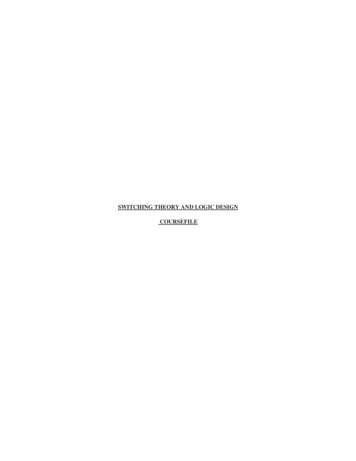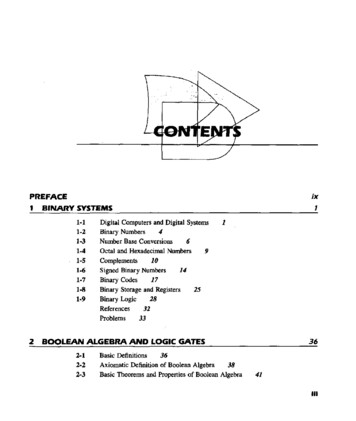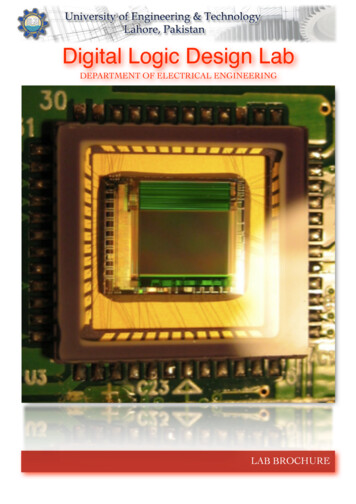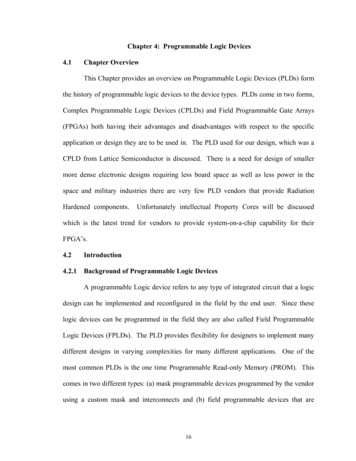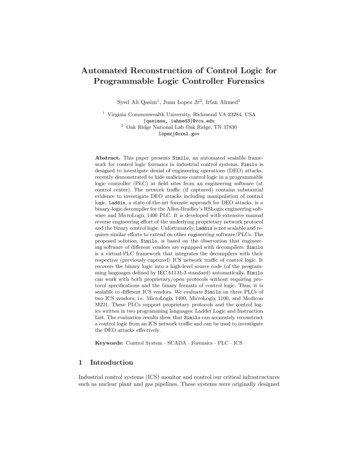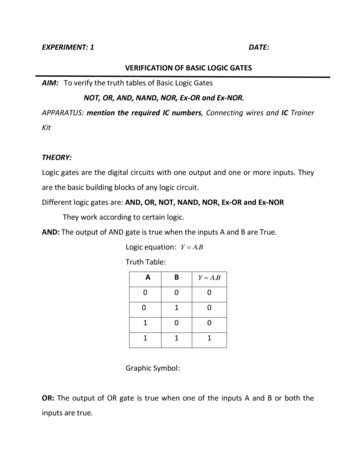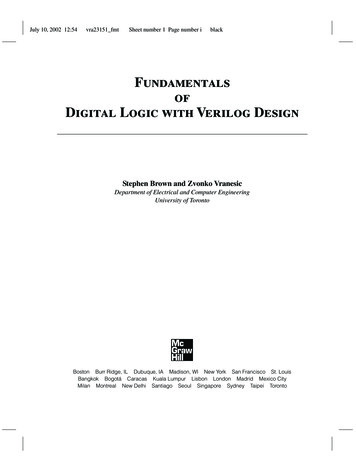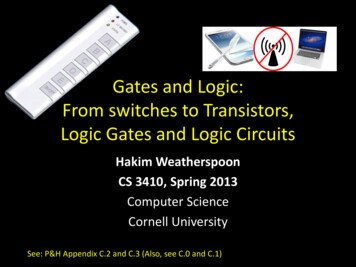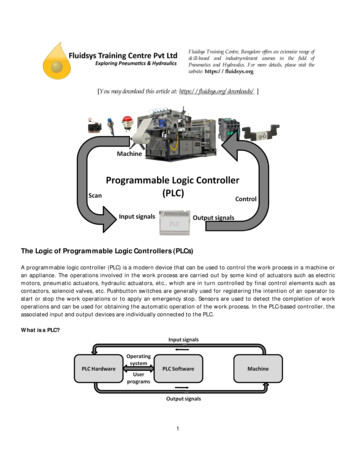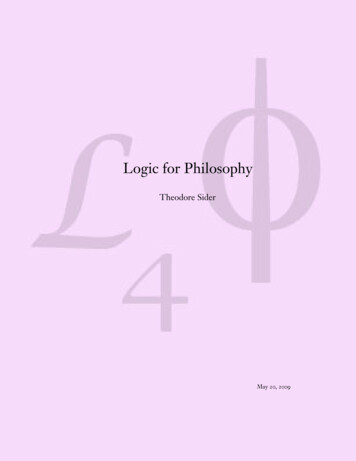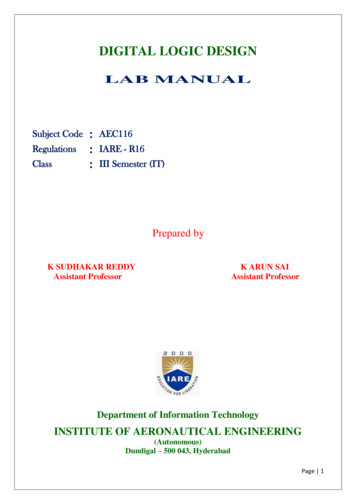
Transcription
DIGITAL LOGIC DESIGNLAB MANUALSubject CodeRegulationsClass:::AEC116IARE - R16III Semester (IT)Prepared byK SUDHAKAR REDDYAssistant ProfessorK ARUN SAIAssistant ProfessorDepartment of Information TechnologyINSTITUTE OF AERONAUTICAL ENGINEERING(Autonomous)Dundigal – 500 043, HyderabadPage 1
INSTITUTE OF AERONAUTICAL ENGINEERING(Autonomous)Dundigal, Hyderabad - 500 043Information TechnologyVisionTo produce professionally competent Electronics and Communication Engineers capable of effectively andefficiently addressing the technical challenges with social responsibility.MissionThe mission of the Department is to provide an academic environment that will ensure high quality education,training and research by keeping the students abreast of latest developments in the field of Electronics andCommunication Engineering aimed at promoting employability, leadership qualities with humanity, ethics,research aptitude and team spirit.Quality PolicyOur policy is to nurture and build diligent and dedicated community of engineers providing a professional andunprejudiced environment, thus justifying the purpose of teaching and satisfying the stake holders.A team of well qualified and experienced professionals ensure quality education with its practical applicationin all areas of the Institute.PhilosophyThe essence of learning lies in pursuing the truth that liberates one from the darkness of ignorance and Instituteof Aeronautical Engineering firmly believes that education is for liberation.Contained therein is the notion that engineering education includes all fields of science that plays a pivotal rolein the development of world-wide community contributing to the progress of civilization. This institute,adhering to the above understanding, is committed to the development of science and technology incongruence with the natural environs. It lays great emphasis on intensive research and education that blendsprofessional skills and high moral standards with a sense of individuality and humanity. We thus promote tieswith local communities and encourage transnational interactions in order to be socially accountable. Thisaccelerates the process of transfiguring the students into complete human beings making the learning processrelevant to life, instilling in them a sense of courtesy and responsibility.Page 2
INSTITUTE OF AERONAUTICAL ENGINEERING(Autonomous)Dundigal, Hyderabad - 500 043Information TechnologyProgram ineering knowledge: An ability to apply knowledge of basic sciences, mathematical skills,engineering and technology to solve complex electronics and communication engineering problems(Fundamental Engineering Analysis Skills).Problem analysis: An ability to identify, formulate and analyze engineering problems using knowledgeof Basic Mathematics and Engineering Sciences. (Engineering Problem Solving Skills).Design/development of solutions: An ability to provide solution and to design Electronics andCommunication Systems as per social needs(Social Awareness)Conduct investigations of complex problems: An ability to investigate the problems in Electronics andCommunication field and develop suitable solutions (Creative Skills).Modern tool usage An ability to use latest hardware and software tools to solve complex engineeringproblems (Software and Hardware Interface).The engineer and society: An ability to apply knowledge of contemporary issues like health, Safety andlegal which influences engineering design ( Social Awareness).Environment and sustainability An ability to have awareness on society and environment forsustainable solutions to Electronics & Communication Engineering problems(Social awareness).Ethics: An ability to demonstrate understanding of professional and ethical responsibilities(Engineeringimpact assessment skills).Individual and team work: An ability to work efficiently as an individual and in multidisciplinaryteams(Team Work).Communication: An ability to communicate effectively and efficiently both in verbal and writtenform(Communication Skills).Project management and finance: An ability to develop confidence to pursue higher education and forlife-long learning(Continuing education awareness).Life-long learning: An ability to design, implement and manage the electronic projects for real worldapplications with optimum financial resources(Practical engineering analysis skills).Program Specific OutcomesPSO1PSO2PSO3Professional Skills: An ability to understand the basic concepts in Electronics & CommunicationEngineering and to apply them to various areas, like Electronics, Communications, Signal processing,VLSI, Embedded systems etc., in the design and implementation of complex systems.Problem-solving skills: An ability to solve complex Electronics and communication Engineeringproblems, using latest hardware and software tools, along with analytical skills to arrive cost effectiveand appropriate solutions.Successful career and Entrepreneurship: An understanding of social-awareness & environmentalwisdom along with ethical responsibility to have a successful career and to sustain passion and zeal forreal-world applications using optimal resources as an Entrepreneur.Page 3
INSTITUTE OF AERONAUTICAL ENGINEERING(Autonomous)Dundigal, Hyderabad - 500 043Information TechnologyATTAINMENT OF PROGRAM OUTCOMES& PROGRAM SPECIFIC OUTCOMESS No.Experiment1.Study of logic gates2.Adders and subtractors3.BCD to Excess-3 code converter4.Binary to Gray code converter5.Multiplexer and De-multiplexer6.Comparators7.Encoder and Decoder8.Flipflops9.Shift registers10.Study of Asynchronous and Synchronous counter.11.Presettable 4bit binary up/down counter12.Study of BCD mesAttainedPO1,PO 12PSO1, PSO2PO1, PO2,PO 12PO1, PO2,PO 12PO1, PO5,PO 12PO1, PO5,PO 12PO1, PO5,PO 12PO1, PO2,PO11PO1, PO2,PO11PO1, PO5,PO 12PO1, PO2,PO11PO1, PO2,PO11PO1, PO2,PO11PSO1, PSO2PSO1, PSO2PSO1, PSO2PSO1, PSO2PSO1, PSO2PSO1, PSO2PSO1, PSO2PSO1, PSO2PSO1, PSO2PSO1, PSO2PSO1, PSO2Page 4
INSTITUTE OF AERONAUTICAL ENGINEERING(Autonomous)Dundigal, Hyderabad - 500 043CertificateThis is to Certify that it is a bonafide record of Practical workdone by Sri/Kum.bearing the Roll No. ofClass Branch inthe laboratory during theAcademic year under our supervision.Head of the DepartmentLecture In-ChargeExternal ExaminerInternal ExaminerPage 5
INSTITUTE OF AERONAUTICAL ENGINEERING(Autonomous)Dundigal - 500 043, HyderabadInformation TechnologyCourse Overview:This course provides the basic knowledge of digital logic levels and application of knowledge to understanddigital electronics circuits. To prepare students to perform the analysis and design of various digital electroniccircuits.Course Out Comes:Upon the completion of Digital logical design practical course, the student will be able to:Understand the logic gates.2. Design adders and subtractors using logic gates.1.3.Design various combinational circuits using logic gates.4.Understand the concepts of asynchronous and synchronous counter.Page 6
INSTITUTE OF AERONAUTICAL ENGINEERING(Autonomous)Dundigal - 500 043, HyderabadInformation TechnologyINSTRUCTIONS TO THE STUDENTS1.Students are required to attend all labs.2.Students should work individually in the hardware and software laboratories.3.Students have to bring the lab manual cum observation book, record etc. along with them wheneverthey come for lab work.4.Should take only the lab manual, calculator (if needed) and a pen or pencil to the work area.5.Should learn the prelab questions. Read through the lab experiment to familiarize themselves with thecomponents and assembly sequence.6.Should utilize 3 hours‟time properly to perform the experiment and to record the readings. Do thecalculations, draw the graphs and take signature from the instructor.7.If the experiment is not completed in the stipulated time, the pending work has to be carried out in theleisure hours or extended hours.8.Should submit the completed record book according to the deadlines set up by the instructor.9.For practical subjects there shall be a continuous evaluation during the semester for 25 sessionalmarks and 50 end examination marks.10.Out of 25 internal marks, 15 marks shall be awarded for day-to-day work and 10awarded by conducting an internal laboratory test.marks to bePage 7
INSTITUTE OF AERONAUTICAL ENGINEERING(Autonomous)Dundigal - 500 043, HyderabadInformation TechnologyDIGITAL LOGIC DESIGNEquipments required:IC trainer kitLogic gate ICsPatch chords, connecting wires.S. No.List of ExperimentsPageNo.1.Study of logic gates92.Adders and subtractors113.BCD to Excess-3 code converter164.Binary to Gray code converter195.Multiplexer and De-multiplexer226.Comparators277.Encoder and Decoder328.Flipflops369.Shift registers4210.Study of Asynchronous and Synchronous counter.4411.Presettable 4bit binary up/down counter5212.Study of BCD counter56Page 8
EXPERIMENT No. 1LOGIC GATES1.1 AIM: To study and verify the truth table of logic gates1.2 LEARNING OBJECTIVE:Identify various ICs and their specification.1.3 COMPONENTS REQUIRED:Logic gates (IC) trainer kit.Connecting patch chords.IC 7400, IC 7408, IC 7432, IC 7406, IC 7402, IC 7404, IC 74861.4 THEORY:The basic logic gates are the building blocks of more complex logic circuits. These logicgates perform the basic Boolean functions, such as AND, OR, NAND, NOR, Inversion, ExclusiveOR, Exclusive-NOR. Fig. below shows the circuit symbol, Boolean function, and truth. It is seen fromthe Fig that each gate has one or two binary inputs, A and B, and one binary output, C. The smallcircle on the output of the circuit symbols designates the logic complement. The AND, OR, NAND,and NOR gates can be extended to have more than two inputs. A gate can be extended to havemultiple inputs if the binary operation it represents is commutative and associative. These basic logicgates are implemented as small-scale integrated circuits (SSICs) or as part of more complex mediumscale (MSI) or very large-scale (VLSI) integrated circuits. Digital IC gates are classified not only bytheir logic operation, but also the specific logic-circuit family to which they belong. Each logic familyhas its own basic electronic circuit upon which more complex digital circuits and functions aredeveloped. The following logic families are the most frequently used.TTL -Transistor-transistor logicECL -Emitter-coupled logicMOS-Metal-oxide semiconductorCMOS-Complementary metal-oxide semiconductorTTL and ECL are based upon bipolar transistors. TTL has a well-established popularity among logicfamilies. ECL is used only in systems requiring high-speed operation. MOS and CMOS, are based onfield effect transistors. They are widely used in large scale integrated circuits because of their highcomponent density and relatively low power consumption. CMOS logic consumes far less power thanMOS logic. There are various commercial integrated circuit chips available. TTL ICs are usuallydistinguished by numerical designation as the 5400 and 7400 series.1.5 PROCEDURE:1. Check the components for their working.2. Insert the appropriate IC into the IC base.3. Make connections as shown in the circuit diagram.4. Provide the input data via the input switches and observe the output on output LEDsPage 9
1.6 Result:Page 10
1.7 VIVA QUESTIONS:1. Why NAND & NOR gates are called universal gates?2. Realize the EX – OR gates using minimum number of NAND gates.3. Give the truth table for EX-NOR and realize using NAND gates?4. What are the logic low and High levels of TTL IC‟s and CMOS IC‟s?5. Compare TTL logic family with CMOS family?6. Which logic family is fastest and which has low power dissipation?Page 11
EXPERIMENT No. 2ADDERS AND SUBTRACTORS2.1 AIM: To realizei) Half Adder and Full Adderii) Half Subtractor and Full Subtractor by using Basic gates and NAND gates2.2 LEARNING OBJECTIVE:To realize the adder and subtractor circuits using basic gates and universal gatesTo realize full adder using two half addersTo realize a full subtractor using two half subtractors2.3 COMPONENTS REQUIRED:IC 7400, IC 7408, IC 7486, IC 7432, Patch Cords & IC Trainer Kit.2.4 THEORY:Half-Adder: A combinational logic circuit that performs the addition of two data bits, A and B,is called a half-adder. Addition will result in two output bits; one of which is the sum bit, S,and the other is the carry bit, C. The Boolean functions describing the half-adder are:S A BC ABFull-Adder: The half-adder does not take the carry bit from its previous stage into account.This carry bit from its previous stage is called carry-in bit. A combinational logic circuit thatadds two data bits, A and B, and a carry-in bit, Cin , is called a full-adder. The Booleanfunctions describing the full-adder are:S (x y) CinC xy Cin (x y)Half Subtractor: Subtracting a single-bit binary value B from another A (i.e. A -B) produces adifference bit D and a borrow out bit B-out. This operation is called half subtraction and thecircuit to realize it is called a half subtractor. The Boolean functions describing the halfSubtractor are:S A BC A‟ BFull Subtractor: Subtracting two single-bit binary values, B, Cin from a single-bit value Aproduces a difference bit D and a borrow out Br bit. This is called full subtraction. The Booleanfunctions describing the full-subtractor are:D (x y) CinBr A‟B A‟(Cin) B(Cin)2.5 PROCEDURE: Check the components for their working. Insert the appropriate IC into the IC base. Make connections as shown in the circuit diagram. Verify the Truth Table and observe the outputs.Page 12
2.6 CIRCUIT DIAGRAM:Half Adder:Truth Table:INPUTSOUTPUTSABSC0000011010101101Full Adder using basic gates:Page 13
TRUTH 101011100111111Half Subtractor using basic gates:Truth TableINPUTSOUTPUTSABDBr0000011110101100Page 14
Full Subtractor:Truth 101010011000111112.7 RESULT:Page 15
2.8 VIVA QUESTIONS:1)What is a half adder?2)What is a full adder?3)What are the applications of adders?4)What is a half subtractor?5)What is a full subtractor?6)What are the applications of subtractors?7)Obtain the minimal expression for above circuits.8)Realize a full adder using two half adders9)Realize a full subtractors using two half subtractorsPage 16
EXPERIMENT No. 3BCD TO EXCESS-3 CODE CONVERTERS3.1 AIM:To design and realize the following using IC 7483.I) BCD to Excess- 3 Code.II) Excess-3 to BCD Code.3.2 LEARNING OBJECTIVE:To learn to realize BCD to Excess-3 code using adder IC 7483To learn to realize Excess-3 to BCD Code using adder IC 74833.3 COMPONENTS REQUIRED:IC 7483, IC 7486, Patch Cords & IC Trainer Kit.3.4 THEORY:Code converter is a combinational circuit that translates the input code word into a newcorresponding word. The excess-3 code digit is obtained by adding three to the corresponding BCDdigit. To Construct a BCD-to-excess-3-code converter with a 4-bit adder feed BCD code to the 4bit adder as the first operand and then feed constant 3 as the second operand. The output is thecorresponding excess-3 code.To make it work as a excess-3 to BCD converter, we feed excess-3 code as the first operand andthen feed 2's complement of 3 as the second operand. The output is the BCD code.3.5 CIRCUIT DIAGRAM:Circuit DiagramPage 17
i) BCD - EXCESS-3 CODEii) EXCESS-3 TO BCD 10111011100010011100110010013.6 PROCEDURE: Check all the components for their working. Insert the appropriate IC into the IC base. Make connections as shown in the circuit diagram. Apply BCD code as first operand(A) and binary 3 as second operand(B) and cin 0 forrealizing BCD-to-Excess-3-code: Apply Excess-3-code code as first operand(A) and binary 3 as second operand(B) and Cin 1for realizing Excess-3-code to BCD. Verify the Truth Table and observe the outputs.3.7 RESULT:Page 18
3.8 VIVA QUESTIONS:1.What is the internal structure of 7483 IC?2.What do you mean by code conversion?3.What are the applications of code conversion?4.How do you realize a subtractor using full adder?5.What is a ripple Adder? What are its disadvantages?Page 19
EXPERIMENT No. 4BINARY TO GRAY CODE CONVERTER4.1 AIM: To realize Binary to Gray code converter.4.2 LEARNING OBJECTIVE:To learn the importance of non-weighted codeTo learn to generate gray code4.3 COMPONENTS REQUIRED:IC 7400, IC 7486, and IC 7408, Patch Cords & IC Trainer Kit4.4 PROCEDURE: Check all the components for their working. Insert the appropriate IC into the IC base. Make connections as shown in the circuit diagram. Verify the Truth Table and observe the outputs.4.5 Circuit Diagram:Binary to Gray Code Using Ex-Or GatesPage 20
1000BOOLEAN EXPRESSIONS:G3 B3G2 B3 B2G1 B1 B2;G0 B1 B04.6 RESULT:Page 21
4.7 VIVA QUESTIONS:1.What are code converters?2.What is the necessity of code conversions?3.What is gray code?4.Realize the Boolean expressions fora) Binary to gray code conversionb) Gray to binary code conversionPage 22
EXPERIMENT No. 5MULTIPLEXER AND DEMULTIPLEXER5.1 AIM:To design and set up the following circuit4:1 Multiplexer (MUX) using only NAND gates.1:4 Demultiplexer (DE-MUX) using only NAND gates.5.2 LEARNING OBJECTIVE:To learn about various applications of multiplexer and de-multiplexerTo learn and understand the working of IC 74153 and IC 74139To learn to realize any function using Multiplexer5.3 THEORY:Multiplexers are very useful components in digital systems. They transfer a large numberof information units over a smaller number of channels, (usually one channel) under thecontrol of selection signals. Multiplexer means many to one. A multiplexer is a circuit withmany inputs but only one output. By using control signals (select lines) we can select anyinput to the output. Multiplexer is also called as data selector because the output bit dependson the input data bit that is selected. The general multiplexer circuit has 2 n input signals, ncontrol/select signals and 1 output signal.De-multiplexers perform the opposite function of multiplexers. They transfer a smallnumber of information units (usually one unit) over a larger number of channels under thecontrol of selection signals. The general de-multiplexer circuit has 1 input signal, ncontrol/select signals and 2n output signals. De-multiplexer circuit can also be realized using adecoder circuit with enable.5.4 COMPONENTS REQUIRED:IC 7400, IC 7410, IC 7420, IC 7404, IC 74153, IC 74139, Patch Cords & IC Trainer Kit.5.5 PROCEDURE: Check all the components for their working. Insert the appropriate IC into the IC base. Make connections as shown in the circuit diagram. Verify the Truth Table and observe the outputs.5.6 CIRCUIT DIAGRAM:4:1 MULTIPLEXERE‟Inputs4:1MUXS0 S1YPage 23
Output Y E‟S1‟S0‟I0 E‟S1‟S0I1 E‟S1S0‟I2 E‟S1S0I3Realization Using NAND GatesTRUTH TABLESelectInputsEnableInputOutputsS1 X1100XX0X0100XX1X1110XXX00110XXX11InputsVERIFY IC 74153 MUX (DUAL 4:1 MULTIPLEXER)Page 24
DE-MUX USING NAND GATESEnable Data SelectInputs Input InputsVERIFICATION OF IC 74139 (DEMUX)OutputsEDS1 S0 Y3 Y2 Y1 Y010XXXXXX01000001010100100110010001111000TRUTH 101010101101101115.7 RESULT:Page 25
5.8 VIVA QUESTIONS:1) What is a multiplexer?2) What is a de-multiplexer?3) What are the applications of multiplexer and de-multiplexer?4) Derive the Boolean expression for multiplexer and de-multiplexer. 5) How do you realize agiven function using multiplexer 6) What is the difference between multiplexer &demultiplexer?7) In 2n to 1 multiplexer how many selection lines are there?8) How to get higher order multiplexers?9) Implement an 8:1 mux using 4:1 mux?Page 26
EXPERIMENT No. 6COMPARATORS6.1 AIM: To realize One & Two Bit Comparator and study of 7485 magnitude comparator.6.2 LEARNING OBJECTIVE:To learn about various applications of comparatorTo learn and understand the working of IC 7485 magnitude comparatorTo learn to realize 8-bit comparator using 4-bit comparator6.3 THEORY:Magnitude Comparator is a logical circuit, which compares two signals A and B andgenerates three logical outputs, whether A B, A B, or A B. IC 7485 is a high speed4-bit Magnitude comparator, which compares two 4-bit words. The A B Input must beheld high for proper compare operation.6.4 COMPONENTS REQUIRED:IC 7400, IC 7410, IC 7420, IC 7432, IC 7486, IC 7402, IC 7408, IC 7404, IC 7485, PatchCords & IC Trainer Kit.6.5 PROCEDURE: Check all the components for their working. Insert the appropriate IC into the IC base. Make connections as shown in the circuit diagram. Verify the Truth Table and observe the outputs.6.6 CIRCUIT DIAGRAM:1-BIT COMPARATORBoolean Expression;A B ABA B ABA B A B ABTRUTH TABLEINPUTSOUTPUTSABA BA BA B00010010011010011010Page 27
2- BIT COMPARATORBoolean Expression:(A B) A1 B1 A0B1B0 B0A1A0(A B) (A0 B0) (A1 B1)(A B) B1A1 B0A1A0 A0B1B02-bit comparator circuit diagramTRUTH 011001100110011B00101010101010101A B0000100011001110OUTPUTSA B1000010000100001A B0111001100010000Page 28
TO COMPARE THE GIVEN DATA USING 7485 CHIP.ABResultA3 A2 A1 A0 B3 B2 B1 B000010000A B00010001A B00000001A B6.7 RESULT:Page 29
6.8 VIVA QUESTIONS:1. What is a comparator?2. What are the applications of comparator?3. Derive the Boolean expressions of one-bit comparator and two bit comparators.4. How do you realize a higher magnitude comparator using lower bit comparator?5. Design a 2 bit comparator using a single Logic gates?6. Design an 8 bit comparator using a two numbers of IC 7485?Page 30
EXPERIMENT No.7ENCODER AND DECODER7.1 AIM:To set up a circuit of Decimal-to-BCD Encoder using IC 74147.To realize a decoder circuit using basic gates and to verify IC 74LS1397.2 LEARNING OBJECTIVE:To learn about various applications of Encoders and Decoder.To learn and understand the working of IC 74147, IC 74LS139.To learn to do code conversion using encoders.7.3 COMPONENTS REQUIRED:IC 74147, IC 74LS139, Patch chords & IC Trainer Kit7.4 THEORY:An encoder performs a function that is the opposite of decoder. It receives one or more signalsin an encoded format and output a code that can be processed by another logic circuit. One of theadvantages of encoding data, or more often data addresses in computers, is that it reduces thenumber of required bits to represent data or addresses. For example, if a memory has 16 differentlocations, in order to access these 16 different locations, 16 lines (bits) are required if theaddressing signals are in 1 out of n format. However, if we code the 16 different addresses into abinary format, then only 4 lines (bits) are required. Such a reduction improves the speed ofinformation processing in digital systems.A decoder is a combinational circuit that connects the binary information from „n‟ input linesto a maximum of 2n unique output lines. Decoder is also called a min-term generator/maxtermgenerator. A min-term generator is constructed using AND and NOT gates. The appropriate outputis indicated by logic 1 (positive logic). Max-term generator is constructed using NAND gates.The appropriate output is indicated by logic 0 (Negative logic). The IC 74139 accepts two binaryinputs and when enable provides 4 individual active low outputs. The device has 2 enable inputs(Two active low).7.5 PROCEDURE:Encoder:Check all the components for their working.Insert the appropriate IC into the IC base.Make connections as shown in the circuit diagram.Verify the Truth Table and observe the outputs.Decoder:Make the connections as per the circuit diagram.Change the values of G1, G2A, G2B, A, B, and C, using switches.Observe status of Y0, to Y7 on LED‟s.Verify the truth table.Page 31
7.6 CIRCUIT DIAGRAM:DECIMAL-TO BCD ENCODER USING IC 74147.TRUTH TABLEINPUTSOUTPUTSI1 I2 I3 I4 I5 I6I7 I8 I9 A3 A2 A1 A01111111100110X X X X X X X 010111X X X X X X0111000X X X X X 01111001X X X X 011111010X X X0111111011X X 2:4 DECODER (MIN TERM GENERATOR):TRUTH TABLE:INPUTA B00011011OUTPUTY0 Y110010000Y20010Y30001BOOLEAN EXPRESSION:Y0 ABY1 ABY2 ABY3 ABPage 32
INPUTAB00011011OUTPUTY0 Y101101111Y21101Y31110TRUTH TABLE2:4 DECODER (MAX TERM GENERATOR):CIRCUIT DIAGRAM:7.7 RESULT:Page 33
7.8 VIVA QUESTIONS:1.2.3.4.5.6.7.8.What is a priority encoder?What is the role of an encoder in communication?What is the advantage of using an encoder?What are the uses of validating outputs?What are the applications of decoder?What is the difference between decoder & encoder?What are code converters?What is the difference between decoder and de-mux?Page 34
EXPERIMENT No. 8FLIP FLOPS8.1 AIM: Truth Table verification of1)RS Flip Flop2)T type Flip Flop.3)D type Flip Flop.4)JK Flip Flop.5)JK Master Slave Flip Flop.8.2 LEARNING OBJECTIVE:To learn about various Flip-FlopsTo learn and understand the working of Master slave FFTo learn about applications of FFsConversion of one type of Flip flop to another8.3 COMPONENTS REQUIRED:IC 7408, IC 7404, IC 7402, IC 7400, Patch Cords & IC Trainer Kit.8.4 THEORY:Logic circuits that incorporate memory cells are called sequential logic circuits; theiroutput depends not only upon the present value of the input but also upon the previous values.Sequential logic circuits often require a timing generator (a clock) for theiroperation. The latch (flip-flop) is a basic bi-stable memory element widely used insequential logic circuits. Usually there are two outputs, Q and its complementary value.Some of the most widely used latches are listed below.SR LATCH:An S-R latch consists of two cross-coupled NOR gates. An S-R flip-flop can also bedesign using cross-coupled NAND gates as shown. The truth tables of the circuits are shownbelow.A clocked S-R flip-flop has an additional clock input so that the S and R inputs are activeonly when the clock is high. When the clock goes low, the state of flip-flop is latched and cannotchange until the clock goes high again. Therefore, the clocked S-R flip-flop is also called“enabled” S-R flip-flop.A D latch combines the S and R inputs of an S-R latch into one input by adding aninverter. When the clock is high, the output follows the D input, and when the clock goes low, thestate is latched.A S-R flip-flop can be converted to T-flip flop by connecting S input to Qb and R to Q.8.5 PROCEDURE: Check all the components for their working. Insert the appropriate IC into the IC base. Make connections as shown in the circuit diagram. Verify the Truth Table and observe the outputs.Page 35
8.6 CIRCUIT DIAGRAM:1)S-R LATCH:(A) LOGIC DIAGRAM(B) SYMBOLPage 36
TRUTH TABLESRQ Qb 00QQb01011010110*0*2) SR-FLIP FLOP:(A) LOGIC DIAGRAM(B) SYMBOLTRUTH TABLESRQ Qb 00QQb01011010110*0*Page 37
3) CONVERSION OF SR-FLIP FLOP TO T-FLIP FLOP (Toggle)LOGIC DIAGRAMT FLIP FLOP USING IC 7476SYMBOLTRUTH TABLETQn 10Qn1Qn4) CONVERSION OF SR-FLIP FLOP TO D-FLIP FLOP :LOGIC DIAGRAMD FLIP FLOP USING IC 7476SYMBOLTRUTH TABLECLOCKDQ Q 0XQQ10011110Page 38
5) CONVERSION OF SR-FLIP FLOP TO JK-FLIP FLOPLOGIC DIAGRAMTRUTH TABLEClock J K Q Q’ CommentLOGIC DIAGRAM100QQ‟No Change10101Reset11010Set111Q‟QToggleTRUTH TABLERD Clock J KQQ’ Comment00Not Allowed01XX X10Set10XX eNC NCMemoryPage 39
6) JK MASTER SLAVE FLIP FLOPLOGIC DIAGRAMTRUTH TABLEPRE CLR 1Clock J K Q Q’ CommentQ‟QNo Change100101 01Reset110 10Set111Race Around8.7 Result:Page 40
8.8 VIVA QUESTIONS:1. What is the difference between Flip-Flop & latch?2. Give examples for synchronous & asynchronous inputs?3. What are the applications of different Flip-Flops?4. What is the advantage of Edge triggering over level triggering?5. What is the relation between propagation delay & clock frequency of flip-flop?6. What is race around in flip-flop & how to overcome it?7. Convert the J K Flip-Flop into D flip-flop and T flip-flop?8. List the functions of asynchronous inputs?Page 41
EXPERIMENT No. 9SHIFT REGISTERS9.1 AIM: To realize and study of Shift Register.1) SISO (Serial in Serial out)2) SIPO (Serial in Parallel out)3) PIPO (Parallel in Parallel out)4) PISO (Parallel in Serial out)9.2 COMPONENTS REQUIRED: IC 7495, Patch Cords & IC Trainer Kit.9.3 PROCEDURE: Check all the components for their working. Insert the appropriate IC into the IC base. Make connections as shown in the circuit diagram. Verify the Truth Table and observe the outputs.9.4 PIN DIAGRAM:1) SERIAL IN SERIAL OUT (SISO) (Right ge 42
2) SERIAL IN PARALLEL OUT (SIPO)Seriali/p X10103) PARALLEL IN PARALLEL OUT LK2t110104) PARALLEL IN SERIAL OUT LK2t11010CLK2t2X1010t3XX101t4XXX1Xt5XXXX9.5 RESULT:Page 43
Page 44
EXPERIMENT No.10STUDY OF ASYNCHRONOUS AND SYNCHRONOUS COUNTER10.1 AIM:To design and test 3-bit binary asynchronous and synchronous counter using flip-flop IC 7476 forthe given sequence.10.2 LEARNING OBJECTIVE:To learn about Asynchronous Counter and its applicationTo learn the design of asynchronous up counter and down counterTo learn about synchronous Counter and its applicationTo learn
8. Should submit the completed record book according to the deadlines set up by the instructor. 9. For practical subjects there shall be a continuous evaluation during the semester for 25 sessional marks and 50 end examination marks. 10. Out of 25 internal marks, 15 marks shall be awarded for day-to-day work and 10 marks to be

